ENGT5146 Assignment B: Design Analysis of House in Different Climates
VerifiedAdded on 2022/08/26
|12
|2422
|22
Report
AI Summary
This report presents a design analysis of a two-bedroom bungalow in Manchester, examining heat gains and losses during the summer. The analysis covers various aspects, including the identification of heat sources (conduction, radiation, infiltration, and internal gains), calculations of internal casual gains, and solar heat gain calculations. The report also calculates total heat gain and natural ventilation, comparing the climates of Manchester and Munich. The study considers building orientation, window specifications, and occupancy patterns, providing a detailed assessment of the building's thermal performance and recommendations for improvement. The report utilizes CIBSE guidelines for calculations and provides a comparative analysis of the two climates, highlighting the need for building adjustments based on the climate differences.
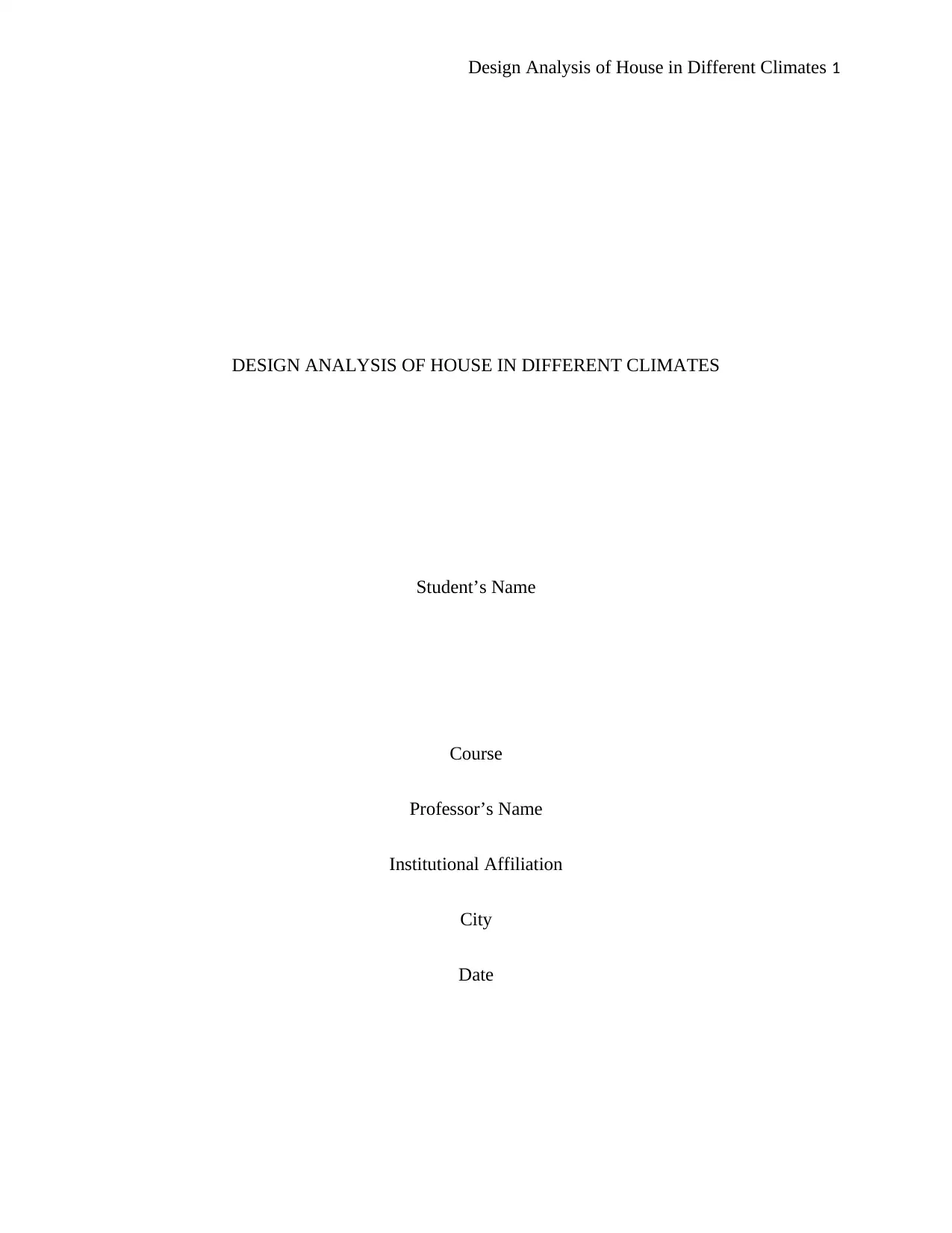
Design Analysis of House in Different Climates 1
DESIGN ANALYSIS OF HOUSE IN DIFFERENT CLIMATES
Student’s Name
Course
Professor’s Name
Institutional Affiliation
City
Date
DESIGN ANALYSIS OF HOUSE IN DIFFERENT CLIMATES
Student’s Name
Course
Professor’s Name
Institutional Affiliation
City
Date
Paraphrase This Document
Need a fresh take? Get an instant paraphrase of this document with our AI Paraphraser
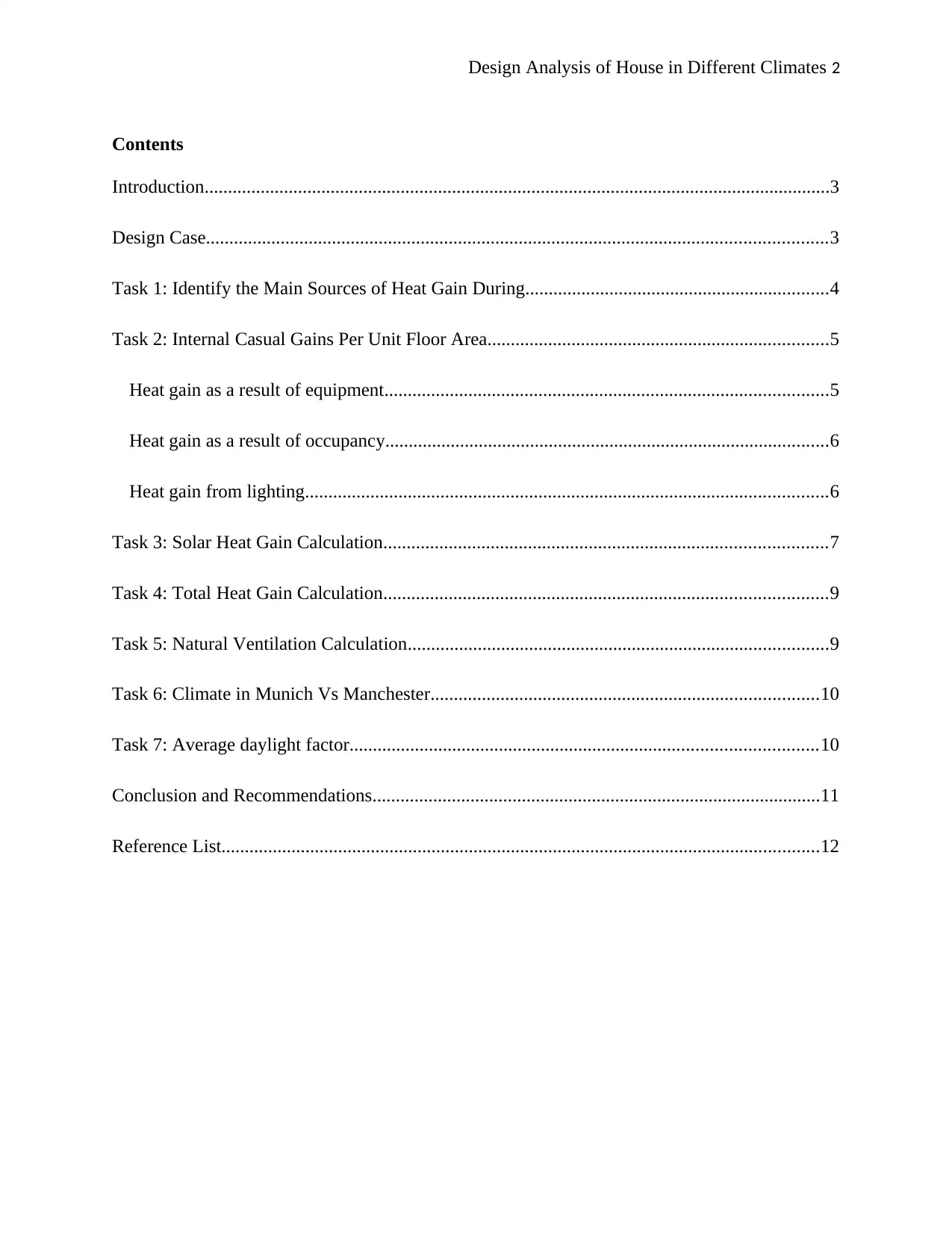
Design Analysis of House in Different Climates 2
Contents
Introduction......................................................................................................................................3
Design Case.....................................................................................................................................3
Task 1: Identify the Main Sources of Heat Gain During.................................................................4
Task 2: Internal Casual Gains Per Unit Floor Area.........................................................................5
Heat gain as a result of equipment...............................................................................................5
Heat gain as a result of occupancy...............................................................................................6
Heat gain from lighting................................................................................................................6
Task 3: Solar Heat Gain Calculation...............................................................................................7
Task 4: Total Heat Gain Calculation...............................................................................................9
Task 5: Natural Ventilation Calculation..........................................................................................9
Task 6: Climate in Munich Vs Manchester...................................................................................10
Task 7: Average daylight factor....................................................................................................10
Conclusion and Recommendations................................................................................................11
Reference List................................................................................................................................12
Contents
Introduction......................................................................................................................................3
Design Case.....................................................................................................................................3
Task 1: Identify the Main Sources of Heat Gain During.................................................................4
Task 2: Internal Casual Gains Per Unit Floor Area.........................................................................5
Heat gain as a result of equipment...............................................................................................5
Heat gain as a result of occupancy...............................................................................................6
Heat gain from lighting................................................................................................................6
Task 3: Solar Heat Gain Calculation...............................................................................................7
Task 4: Total Heat Gain Calculation...............................................................................................9
Task 5: Natural Ventilation Calculation..........................................................................................9
Task 6: Climate in Munich Vs Manchester...................................................................................10
Task 7: Average daylight factor....................................................................................................10
Conclusion and Recommendations................................................................................................11
Reference List................................................................................................................................12
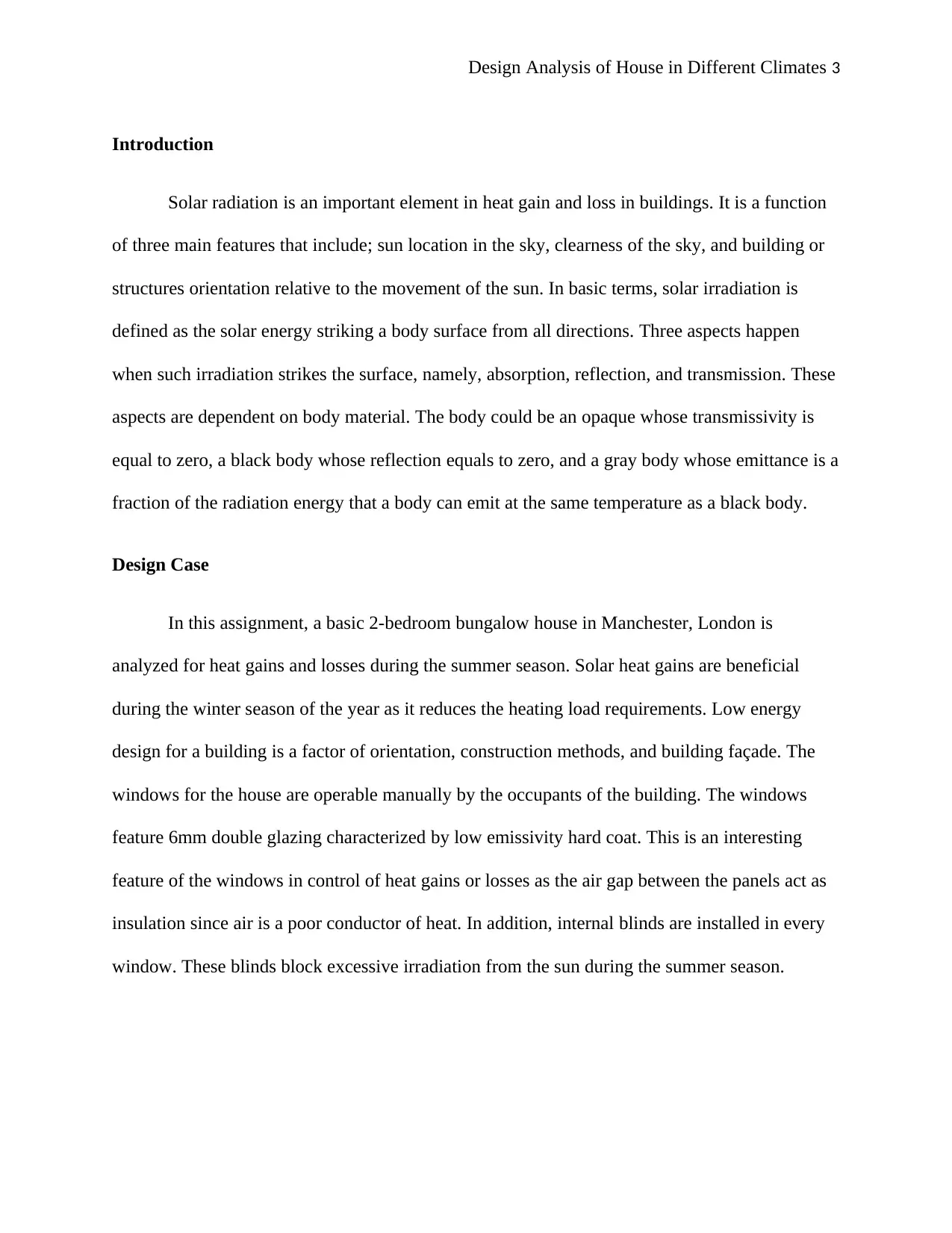
Design Analysis of House in Different Climates 3
Introduction
Solar radiation is an important element in heat gain and loss in buildings. It is a function
of three main features that include; sun location in the sky, clearness of the sky, and building or
structures orientation relative to the movement of the sun. In basic terms, solar irradiation is
defined as the solar energy striking a body surface from all directions. Three aspects happen
when such irradiation strikes the surface, namely, absorption, reflection, and transmission. These
aspects are dependent on body material. The body could be an opaque whose transmissivity is
equal to zero, a black body whose reflection equals to zero, and a gray body whose emittance is a
fraction of the radiation energy that a body can emit at the same temperature as a black body.
Design Case
In this assignment, a basic 2-bedroom bungalow house in Manchester, London is
analyzed for heat gains and losses during the summer season. Solar heat gains are beneficial
during the winter season of the year as it reduces the heating load requirements. Low energy
design for a building is a factor of orientation, construction methods, and building façade. The
windows for the house are operable manually by the occupants of the building. The windows
feature 6mm double glazing characterized by low emissivity hard coat. This is an interesting
feature of the windows in control of heat gains or losses as the air gap between the panels act as
insulation since air is a poor conductor of heat. In addition, internal blinds are installed in every
window. These blinds block excessive irradiation from the sun during the summer season.
Introduction
Solar radiation is an important element in heat gain and loss in buildings. It is a function
of three main features that include; sun location in the sky, clearness of the sky, and building or
structures orientation relative to the movement of the sun. In basic terms, solar irradiation is
defined as the solar energy striking a body surface from all directions. Three aspects happen
when such irradiation strikes the surface, namely, absorption, reflection, and transmission. These
aspects are dependent on body material. The body could be an opaque whose transmissivity is
equal to zero, a black body whose reflection equals to zero, and a gray body whose emittance is a
fraction of the radiation energy that a body can emit at the same temperature as a black body.
Design Case
In this assignment, a basic 2-bedroom bungalow house in Manchester, London is
analyzed for heat gains and losses during the summer season. Solar heat gains are beneficial
during the winter season of the year as it reduces the heating load requirements. Low energy
design for a building is a factor of orientation, construction methods, and building façade. The
windows for the house are operable manually by the occupants of the building. The windows
feature 6mm double glazing characterized by low emissivity hard coat. This is an interesting
feature of the windows in control of heat gains or losses as the air gap between the panels act as
insulation since air is a poor conductor of heat. In addition, internal blinds are installed in every
window. These blinds block excessive irradiation from the sun during the summer season.
⊘ This is a preview!⊘
Do you want full access?
Subscribe today to unlock all pages.

Trusted by 1+ million students worldwide
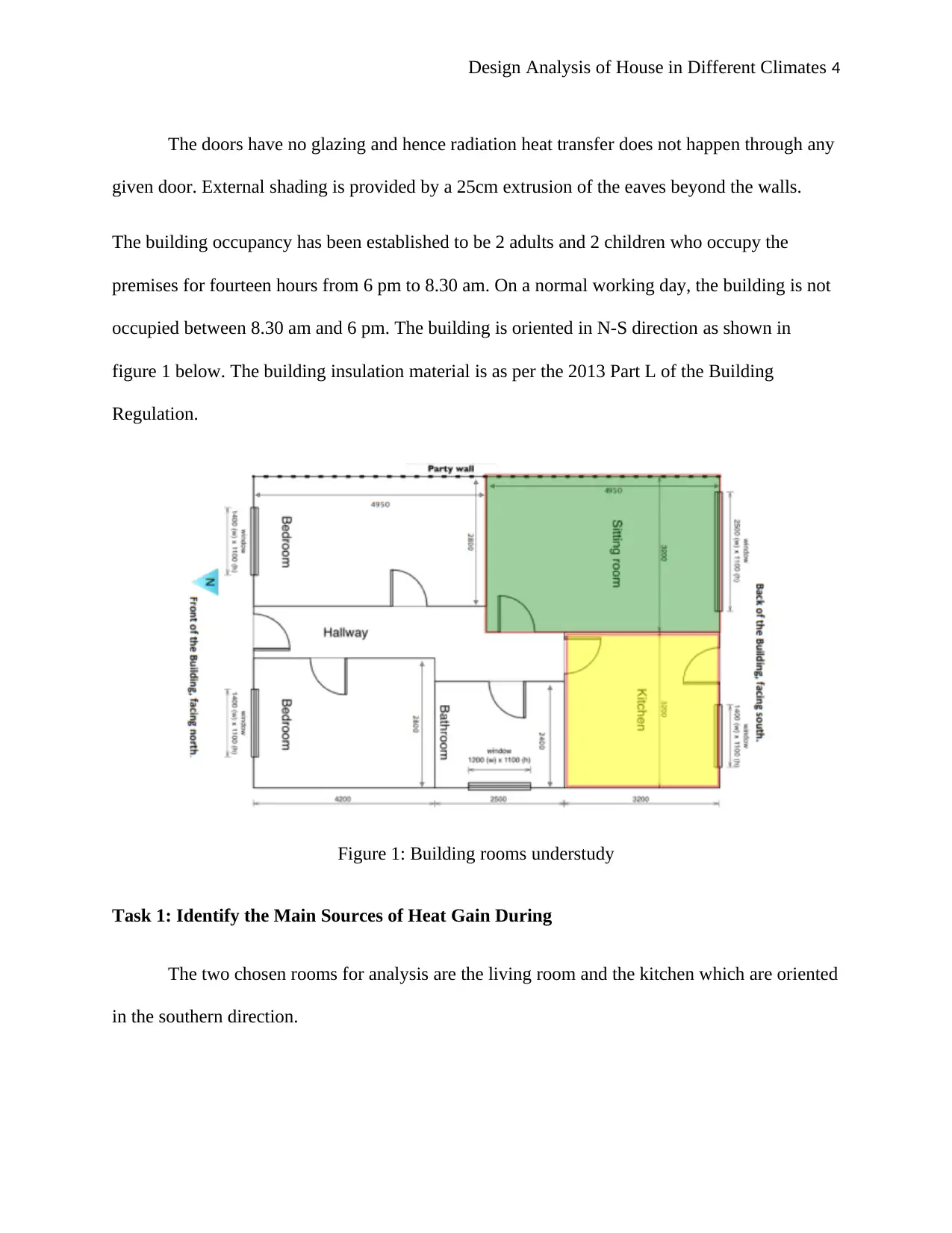
Design Analysis of House in Different Climates 4
The doors have no glazing and hence radiation heat transfer does not happen through any
given door. External shading is provided by a 25cm extrusion of the eaves beyond the walls.
The building occupancy has been established to be 2 adults and 2 children who occupy the
premises for fourteen hours from 6 pm to 8.30 am. On a normal working day, the building is not
occupied between 8.30 am and 6 pm. The building is oriented in N-S direction as shown in
figure 1 below. The building insulation material is as per the 2013 Part L of the Building
Regulation.
Figure 1: Building rooms understudy
Task 1: Identify the Main Sources of Heat Gain During
The two chosen rooms for analysis are the living room and the kitchen which are oriented
in the southern direction.
The doors have no glazing and hence radiation heat transfer does not happen through any
given door. External shading is provided by a 25cm extrusion of the eaves beyond the walls.
The building occupancy has been established to be 2 adults and 2 children who occupy the
premises for fourteen hours from 6 pm to 8.30 am. On a normal working day, the building is not
occupied between 8.30 am and 6 pm. The building is oriented in N-S direction as shown in
figure 1 below. The building insulation material is as per the 2013 Part L of the Building
Regulation.
Figure 1: Building rooms understudy
Task 1: Identify the Main Sources of Heat Gain During
The two chosen rooms for analysis are the living room and the kitchen which are oriented
in the southern direction.
Paraphrase This Document
Need a fresh take? Get an instant paraphrase of this document with our AI Paraphraser
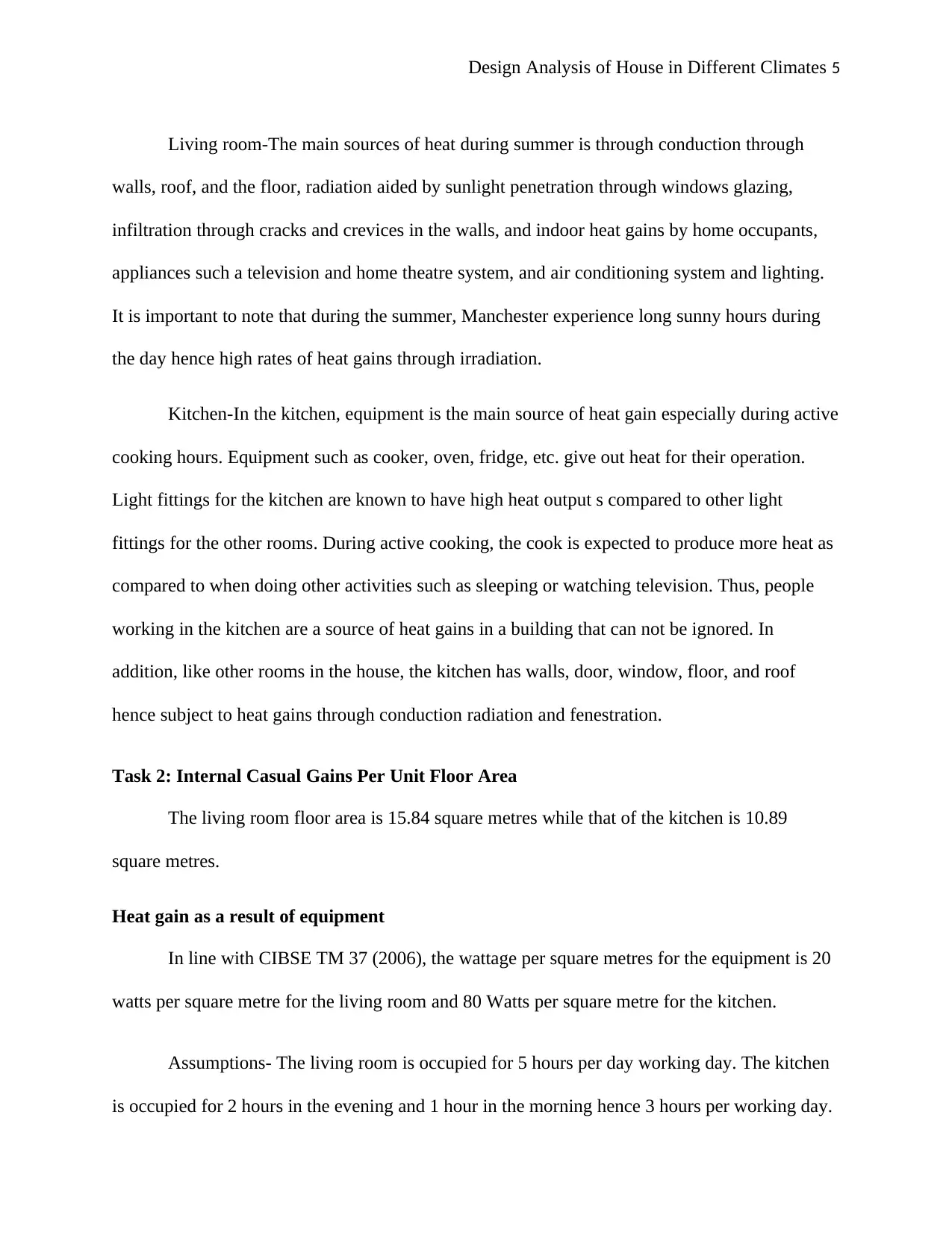
Design Analysis of House in Different Climates 5
Living room-The main sources of heat during summer is through conduction through
walls, roof, and the floor, radiation aided by sunlight penetration through windows glazing,
infiltration through cracks and crevices in the walls, and indoor heat gains by home occupants,
appliances such a television and home theatre system, and air conditioning system and lighting.
It is important to note that during the summer, Manchester experience long sunny hours during
the day hence high rates of heat gains through irradiation.
Kitchen-In the kitchen, equipment is the main source of heat gain especially during active
cooking hours. Equipment such as cooker, oven, fridge, etc. give out heat for their operation.
Light fittings for the kitchen are known to have high heat output s compared to other light
fittings for the other rooms. During active cooking, the cook is expected to produce more heat as
compared to when doing other activities such as sleeping or watching television. Thus, people
working in the kitchen are a source of heat gains in a building that can not be ignored. In
addition, like other rooms in the house, the kitchen has walls, door, window, floor, and roof
hence subject to heat gains through conduction radiation and fenestration.
Task 2: Internal Casual Gains Per Unit Floor Area
The living room floor area is 15.84 square metres while that of the kitchen is 10.89
square metres.
Heat gain as a result of equipment
In line with CIBSE TM 37 (2006), the wattage per square metres for the equipment is 20
watts per square metre for the living room and 80 Watts per square metre for the kitchen.
Assumptions- The living room is occupied for 5 hours per day working day. The kitchen
is occupied for 2 hours in the evening and 1 hour in the morning hence 3 hours per working day.
Living room-The main sources of heat during summer is through conduction through
walls, roof, and the floor, radiation aided by sunlight penetration through windows glazing,
infiltration through cracks and crevices in the walls, and indoor heat gains by home occupants,
appliances such a television and home theatre system, and air conditioning system and lighting.
It is important to note that during the summer, Manchester experience long sunny hours during
the day hence high rates of heat gains through irradiation.
Kitchen-In the kitchen, equipment is the main source of heat gain especially during active
cooking hours. Equipment such as cooker, oven, fridge, etc. give out heat for their operation.
Light fittings for the kitchen are known to have high heat output s compared to other light
fittings for the other rooms. During active cooking, the cook is expected to produce more heat as
compared to when doing other activities such as sleeping or watching television. Thus, people
working in the kitchen are a source of heat gains in a building that can not be ignored. In
addition, like other rooms in the house, the kitchen has walls, door, window, floor, and roof
hence subject to heat gains through conduction radiation and fenestration.
Task 2: Internal Casual Gains Per Unit Floor Area
The living room floor area is 15.84 square metres while that of the kitchen is 10.89
square metres.
Heat gain as a result of equipment
In line with CIBSE TM 37 (2006), the wattage per square metres for the equipment is 20
watts per square metre for the living room and 80 Watts per square metre for the kitchen.
Assumptions- The living room is occupied for 5 hours per day working day. The kitchen
is occupied for 2 hours in the evening and 1 hour in the morning hence 3 hours per working day.
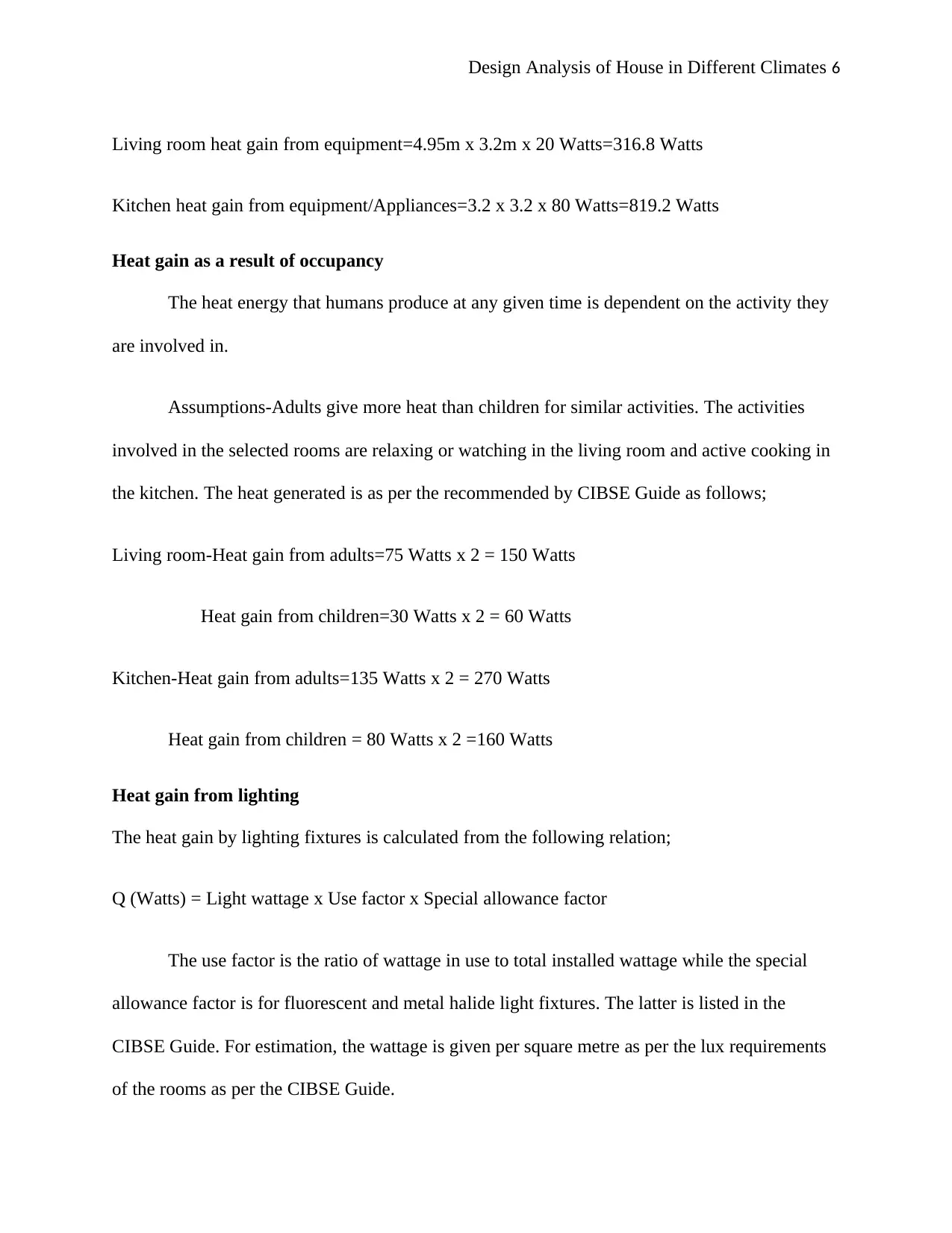
Design Analysis of House in Different Climates 6
Living room heat gain from equipment=4.95m x 3.2m x 20 Watts=316.8 Watts
Kitchen heat gain from equipment/Appliances=3.2 x 3.2 x 80 Watts=819.2 Watts
Heat gain as a result of occupancy
The heat energy that humans produce at any given time is dependent on the activity they
are involved in.
Assumptions-Adults give more heat than children for similar activities. The activities
involved in the selected rooms are relaxing or watching in the living room and active cooking in
the kitchen. The heat generated is as per the recommended by CIBSE Guide as follows;
Living room-Heat gain from adults=75 Watts x 2 = 150 Watts
Heat gain from children=30 Watts x 2 = 60 Watts
Kitchen-Heat gain from adults=135 Watts x 2 = 270 Watts
Heat gain from children = 80 Watts x 2 =160 Watts
Heat gain from lighting
The heat gain by lighting fixtures is calculated from the following relation;
Q (Watts) = Light wattage x Use factor x Special allowance factor
The use factor is the ratio of wattage in use to total installed wattage while the special
allowance factor is for fluorescent and metal halide light fixtures. The latter is listed in the
CIBSE Guide. For estimation, the wattage is given per square metre as per the lux requirements
of the rooms as per the CIBSE Guide.
Living room heat gain from equipment=4.95m x 3.2m x 20 Watts=316.8 Watts
Kitchen heat gain from equipment/Appliances=3.2 x 3.2 x 80 Watts=819.2 Watts
Heat gain as a result of occupancy
The heat energy that humans produce at any given time is dependent on the activity they
are involved in.
Assumptions-Adults give more heat than children for similar activities. The activities
involved in the selected rooms are relaxing or watching in the living room and active cooking in
the kitchen. The heat generated is as per the recommended by CIBSE Guide as follows;
Living room-Heat gain from adults=75 Watts x 2 = 150 Watts
Heat gain from children=30 Watts x 2 = 60 Watts
Kitchen-Heat gain from adults=135 Watts x 2 = 270 Watts
Heat gain from children = 80 Watts x 2 =160 Watts
Heat gain from lighting
The heat gain by lighting fixtures is calculated from the following relation;
Q (Watts) = Light wattage x Use factor x Special allowance factor
The use factor is the ratio of wattage in use to total installed wattage while the special
allowance factor is for fluorescent and metal halide light fixtures. The latter is listed in the
CIBSE Guide. For estimation, the wattage is given per square metre as per the lux requirements
of the rooms as per the CIBSE Guide.
⊘ This is a preview!⊘
Do you want full access?
Subscribe today to unlock all pages.

Trusted by 1+ million students worldwide
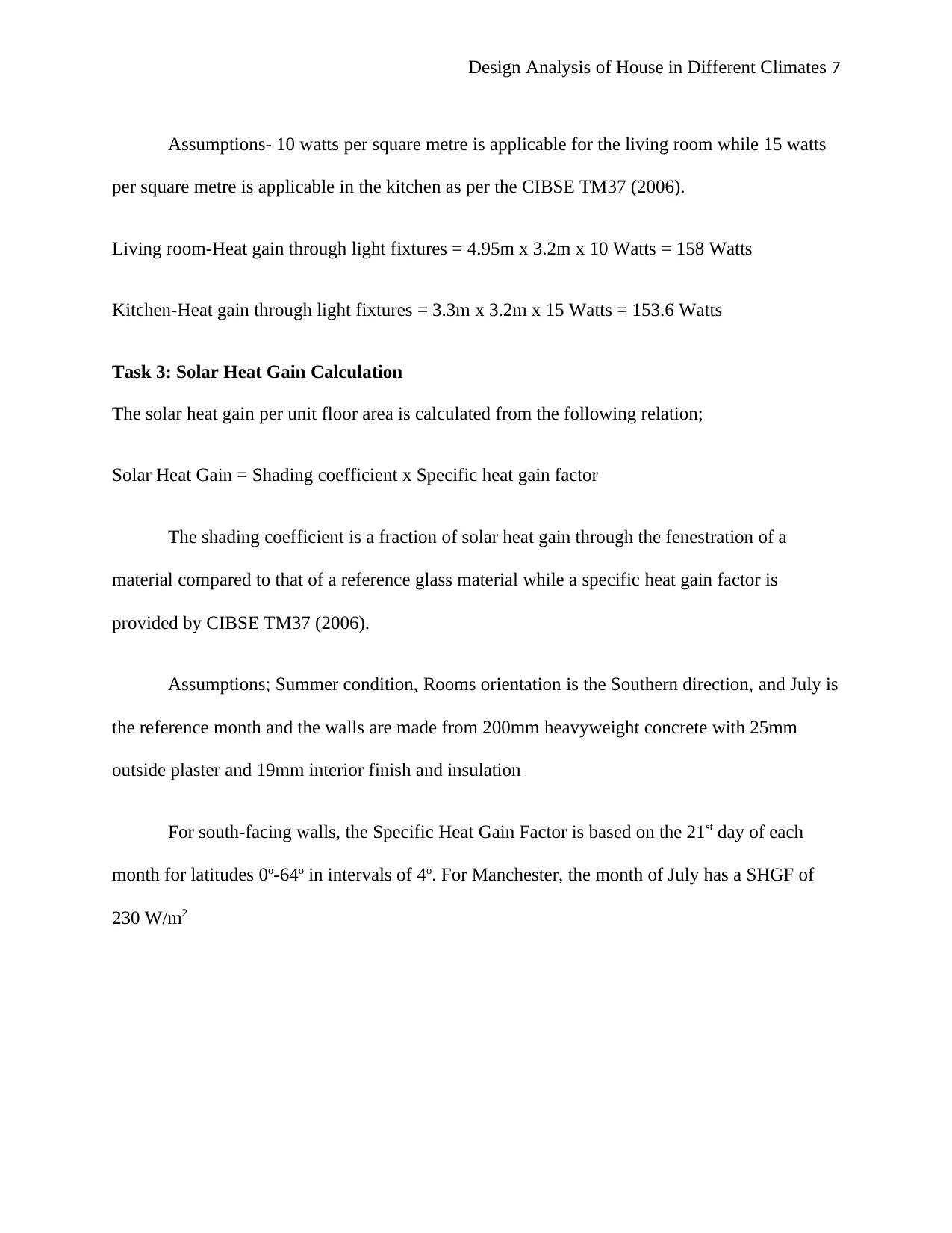
Design Analysis of House in Different Climates 7
Assumptions- 10 watts per square metre is applicable for the living room while 15 watts
per square metre is applicable in the kitchen as per the CIBSE TM37 (2006).
Living room-Heat gain through light fixtures = 4.95m x 3.2m x 10 Watts = 158 Watts
Kitchen-Heat gain through light fixtures = 3.3m x 3.2m x 15 Watts = 153.6 Watts
Task 3: Solar Heat Gain Calculation
The solar heat gain per unit floor area is calculated from the following relation;
Solar Heat Gain = Shading coefficient x Specific heat gain factor
The shading coefficient is a fraction of solar heat gain through the fenestration of a
material compared to that of a reference glass material while a specific heat gain factor is
provided by CIBSE TM37 (2006).
Assumptions; Summer condition, Rooms orientation is the Southern direction, and July is
the reference month and the walls are made from 200mm heavyweight concrete with 25mm
outside plaster and 19mm interior finish and insulation
For south-facing walls, the Specific Heat Gain Factor is based on the 21st day of each
month for latitudes 0o-64o in intervals of 4o. For Manchester, the month of July has a SHGF of
230 W/m2
Assumptions- 10 watts per square metre is applicable for the living room while 15 watts
per square metre is applicable in the kitchen as per the CIBSE TM37 (2006).
Living room-Heat gain through light fixtures = 4.95m x 3.2m x 10 Watts = 158 Watts
Kitchen-Heat gain through light fixtures = 3.3m x 3.2m x 15 Watts = 153.6 Watts
Task 3: Solar Heat Gain Calculation
The solar heat gain per unit floor area is calculated from the following relation;
Solar Heat Gain = Shading coefficient x Specific heat gain factor
The shading coefficient is a fraction of solar heat gain through the fenestration of a
material compared to that of a reference glass material while a specific heat gain factor is
provided by CIBSE TM37 (2006).
Assumptions; Summer condition, Rooms orientation is the Southern direction, and July is
the reference month and the walls are made from 200mm heavyweight concrete with 25mm
outside plaster and 19mm interior finish and insulation
For south-facing walls, the Specific Heat Gain Factor is based on the 21st day of each
month for latitudes 0o-64o in intervals of 4o. For Manchester, the month of July has a SHGF of
230 W/m2
Paraphrase This Document
Need a fresh take? Get an instant paraphrase of this document with our AI Paraphraser
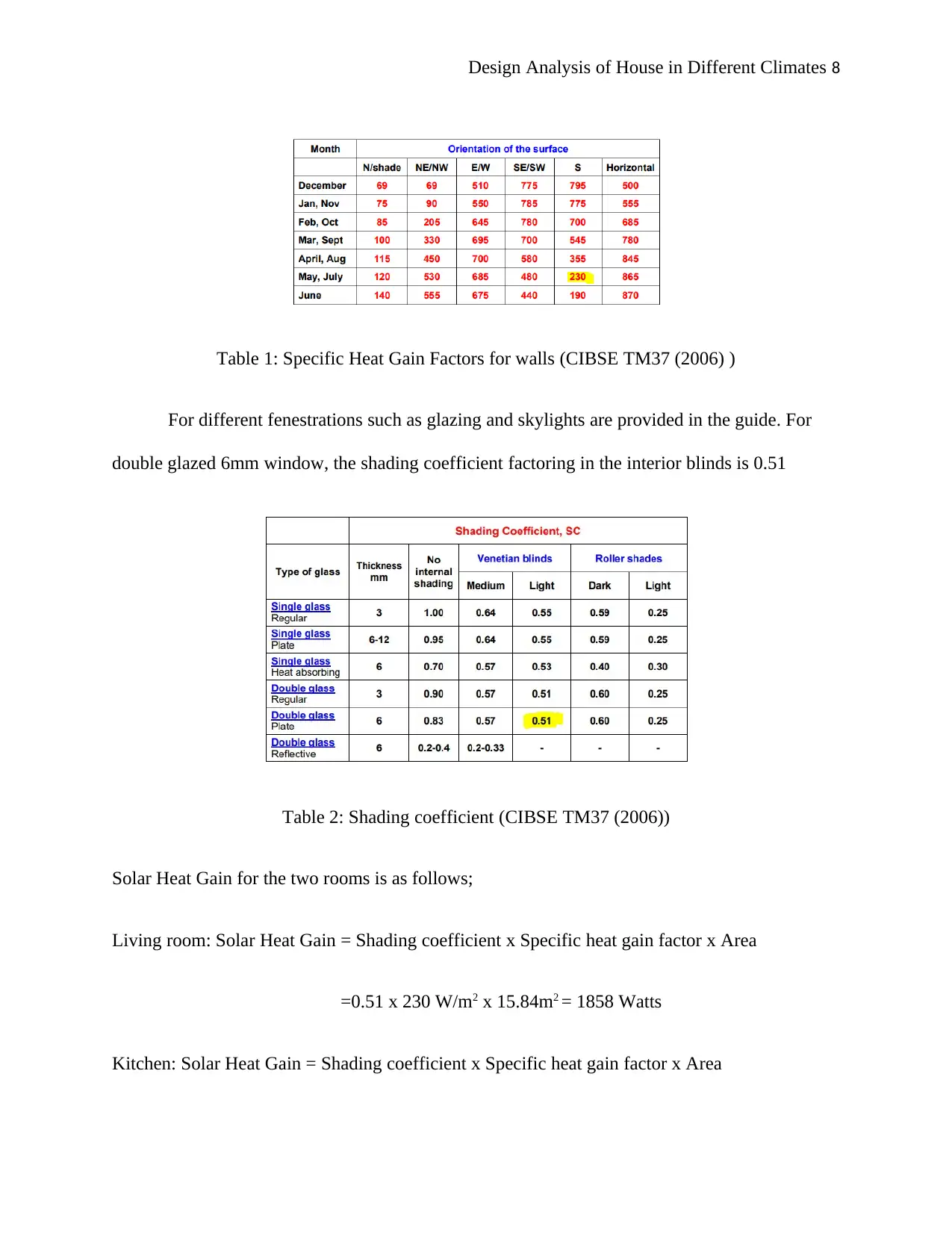
Design Analysis of House in Different Climates 8
Table 1: Specific Heat Gain Factors for walls (CIBSE TM37 (2006) )
For different fenestrations such as glazing and skylights are provided in the guide. For
double glazed 6mm window, the shading coefficient factoring in the interior blinds is 0.51
Table 2: Shading coefficient (CIBSE TM37 (2006))
Solar Heat Gain for the two rooms is as follows;
Living room: Solar Heat Gain = Shading coefficient x Specific heat gain factor x Area
=0.51 x 230 W/m2 x 15.84m2 = 1858 Watts
Kitchen: Solar Heat Gain = Shading coefficient x Specific heat gain factor x Area
Table 1: Specific Heat Gain Factors for walls (CIBSE TM37 (2006) )
For different fenestrations such as glazing and skylights are provided in the guide. For
double glazed 6mm window, the shading coefficient factoring in the interior blinds is 0.51
Table 2: Shading coefficient (CIBSE TM37 (2006))
Solar Heat Gain for the two rooms is as follows;
Living room: Solar Heat Gain = Shading coefficient x Specific heat gain factor x Area
=0.51 x 230 W/m2 x 15.84m2 = 1858 Watts
Kitchen: Solar Heat Gain = Shading coefficient x Specific heat gain factor x Area
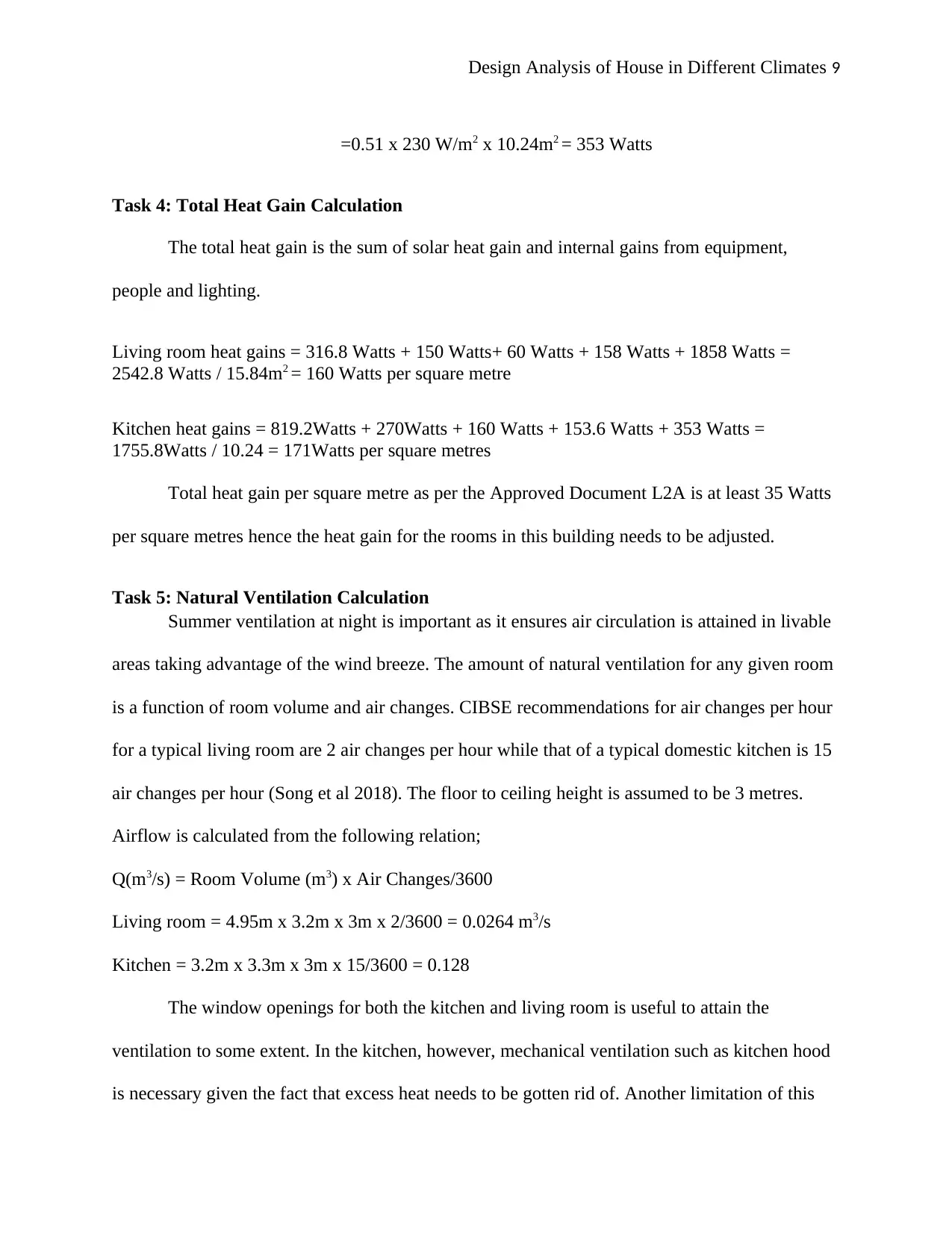
Design Analysis of House in Different Climates 9
=0.51 x 230 W/m2 x 10.24m2 = 353 Watts
Task 4: Total Heat Gain Calculation
The total heat gain is the sum of solar heat gain and internal gains from equipment,
people and lighting.
Living room heat gains = 316.8 Watts + 150 Watts+ 60 Watts + 158 Watts + 1858 Watts =
2542.8 Watts / 15.84m2 = 160 Watts per square metre
Kitchen heat gains = 819.2Watts + 270Watts + 160 Watts + 153.6 Watts + 353 Watts =
1755.8Watts / 10.24 = 171Watts per square metres
Total heat gain per square metre as per the Approved Document L2A is at least 35 Watts
per square metres hence the heat gain for the rooms in this building needs to be adjusted.
Task 5: Natural Ventilation Calculation
Summer ventilation at night is important as it ensures air circulation is attained in livable
areas taking advantage of the wind breeze. The amount of natural ventilation for any given room
is a function of room volume and air changes. CIBSE recommendations for air changes per hour
for a typical living room are 2 air changes per hour while that of a typical domestic kitchen is 15
air changes per hour (Song et al 2018). The floor to ceiling height is assumed to be 3 metres.
Airflow is calculated from the following relation;
Q(m3/s) = Room Volume (m3) x Air Changes/3600
Living room = 4.95m x 3.2m x 3m x 2/3600 = 0.0264 m3/s
Kitchen = 3.2m x 3.3m x 3m x 15/3600 = 0.128
The window openings for both the kitchen and living room is useful to attain the
ventilation to some extent. In the kitchen, however, mechanical ventilation such as kitchen hood
is necessary given the fact that excess heat needs to be gotten rid of. Another limitation of this
=0.51 x 230 W/m2 x 10.24m2 = 353 Watts
Task 4: Total Heat Gain Calculation
The total heat gain is the sum of solar heat gain and internal gains from equipment,
people and lighting.
Living room heat gains = 316.8 Watts + 150 Watts+ 60 Watts + 158 Watts + 1858 Watts =
2542.8 Watts / 15.84m2 = 160 Watts per square metre
Kitchen heat gains = 819.2Watts + 270Watts + 160 Watts + 153.6 Watts + 353 Watts =
1755.8Watts / 10.24 = 171Watts per square metres
Total heat gain per square metre as per the Approved Document L2A is at least 35 Watts
per square metres hence the heat gain for the rooms in this building needs to be adjusted.
Task 5: Natural Ventilation Calculation
Summer ventilation at night is important as it ensures air circulation is attained in livable
areas taking advantage of the wind breeze. The amount of natural ventilation for any given room
is a function of room volume and air changes. CIBSE recommendations for air changes per hour
for a typical living room are 2 air changes per hour while that of a typical domestic kitchen is 15
air changes per hour (Song et al 2018). The floor to ceiling height is assumed to be 3 metres.
Airflow is calculated from the following relation;
Q(m3/s) = Room Volume (m3) x Air Changes/3600
Living room = 4.95m x 3.2m x 3m x 2/3600 = 0.0264 m3/s
Kitchen = 3.2m x 3.3m x 3m x 15/3600 = 0.128
The window openings for both the kitchen and living room is useful to attain the
ventilation to some extent. In the kitchen, however, mechanical ventilation such as kitchen hood
is necessary given the fact that excess heat needs to be gotten rid of. Another limitation of this
⊘ This is a preview!⊘
Do you want full access?
Subscribe today to unlock all pages.

Trusted by 1+ million students worldwide
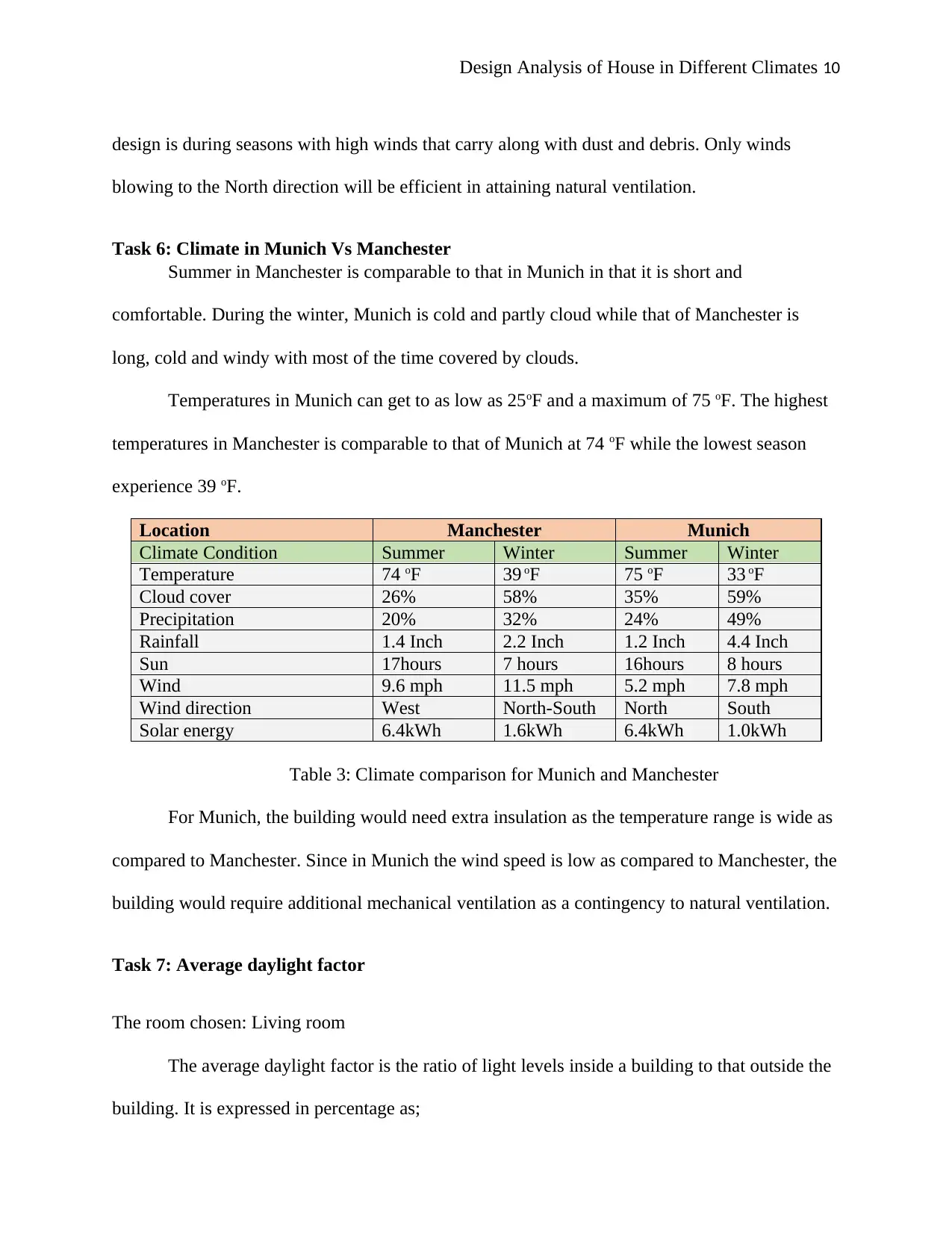
Design Analysis of House in Different Climates 10
design is during seasons with high winds that carry along with dust and debris. Only winds
blowing to the North direction will be efficient in attaining natural ventilation.
Task 6: Climate in Munich Vs Manchester
Summer in Manchester is comparable to that in Munich in that it is short and
comfortable. During the winter, Munich is cold and partly cloud while that of Manchester is
long, cold and windy with most of the time covered by clouds.
Temperatures in Munich can get to as low as 25oF and a maximum of 75 oF. The highest
temperatures in Manchester is comparable to that of Munich at 74 oF while the lowest season
experience 39 oF.
Location Manchester Munich
Climate Condition Summer Winter Summer Winter
Temperature 74 oF 39 oF 75 oF 33 oF
Cloud cover 26% 58% 35% 59%
Precipitation 20% 32% 24% 49%
Rainfall 1.4 Inch 2.2 Inch 1.2 Inch 4.4 Inch
Sun 17hours 7 hours 16hours 8 hours
Wind 9.6 mph 11.5 mph 5.2 mph 7.8 mph
Wind direction West North-South North South
Solar energy 6.4kWh 1.6kWh 6.4kWh 1.0kWh
Table 3: Climate comparison for Munich and Manchester
For Munich, the building would need extra insulation as the temperature range is wide as
compared to Manchester. Since in Munich the wind speed is low as compared to Manchester, the
building would require additional mechanical ventilation as a contingency to natural ventilation.
Task 7: Average daylight factor
The room chosen: Living room
The average daylight factor is the ratio of light levels inside a building to that outside the
building. It is expressed in percentage as;
design is during seasons with high winds that carry along with dust and debris. Only winds
blowing to the North direction will be efficient in attaining natural ventilation.
Task 6: Climate in Munich Vs Manchester
Summer in Manchester is comparable to that in Munich in that it is short and
comfortable. During the winter, Munich is cold and partly cloud while that of Manchester is
long, cold and windy with most of the time covered by clouds.
Temperatures in Munich can get to as low as 25oF and a maximum of 75 oF. The highest
temperatures in Manchester is comparable to that of Munich at 74 oF while the lowest season
experience 39 oF.
Location Manchester Munich
Climate Condition Summer Winter Summer Winter
Temperature 74 oF 39 oF 75 oF 33 oF
Cloud cover 26% 58% 35% 59%
Precipitation 20% 32% 24% 49%
Rainfall 1.4 Inch 2.2 Inch 1.2 Inch 4.4 Inch
Sun 17hours 7 hours 16hours 8 hours
Wind 9.6 mph 11.5 mph 5.2 mph 7.8 mph
Wind direction West North-South North South
Solar energy 6.4kWh 1.6kWh 6.4kWh 1.0kWh
Table 3: Climate comparison for Munich and Manchester
For Munich, the building would need extra insulation as the temperature range is wide as
compared to Manchester. Since in Munich the wind speed is low as compared to Manchester, the
building would require additional mechanical ventilation as a contingency to natural ventilation.
Task 7: Average daylight factor
The room chosen: Living room
The average daylight factor is the ratio of light levels inside a building to that outside the
building. It is expressed in percentage as;
Paraphrase This Document
Need a fresh take? Get an instant paraphrase of this document with our AI Paraphraser
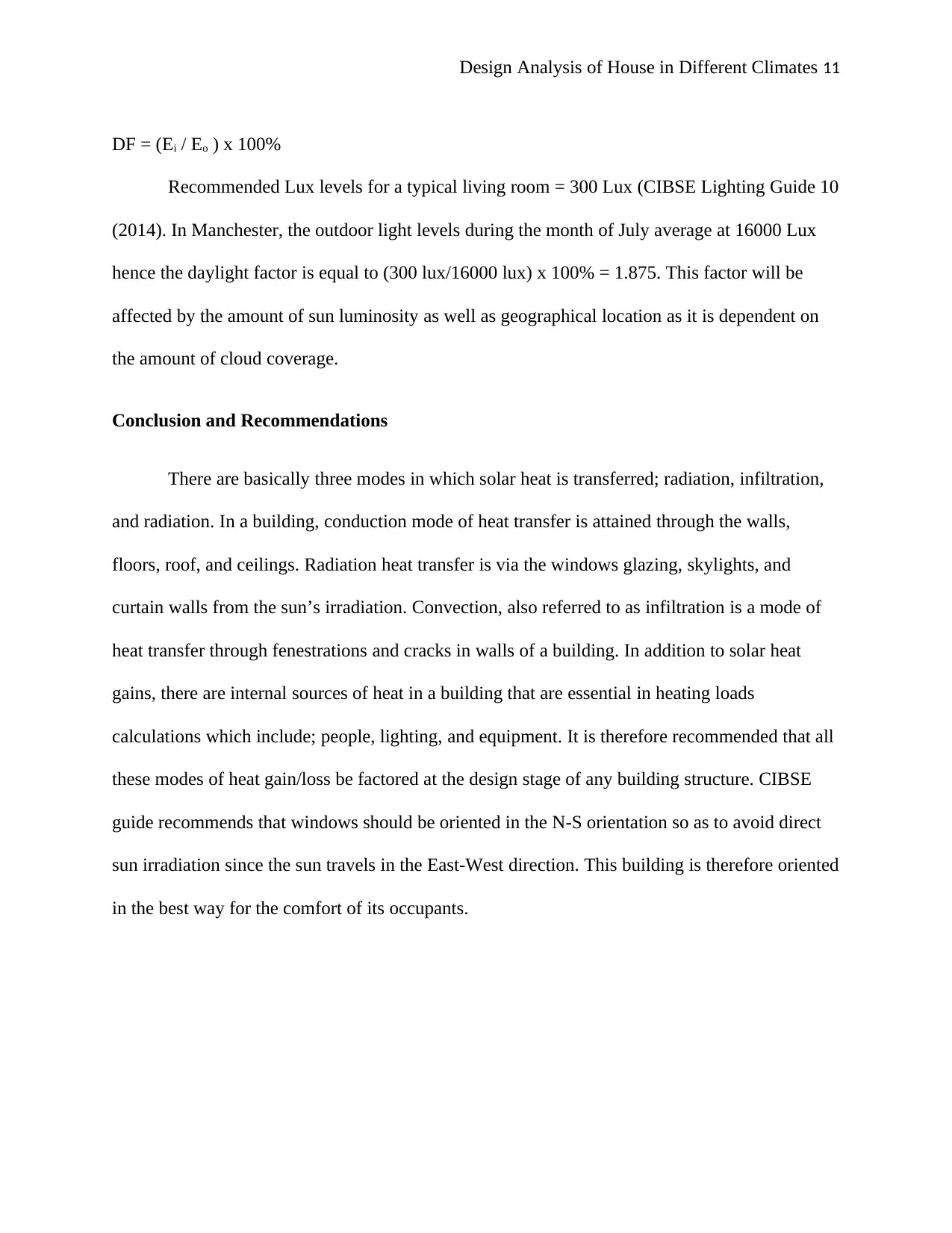
Design Analysis of House in Different Climates 11
DF = (Ei / Eo ) x 100%
Recommended Lux levels for a typical living room = 300 Lux (CIBSE Lighting Guide 10
(2014). In Manchester, the outdoor light levels during the month of July average at 16000 Lux
hence the daylight factor is equal to (300 lux/16000 lux) x 100% = 1.875. This factor will be
affected by the amount of sun luminosity as well as geographical location as it is dependent on
the amount of cloud coverage.
Conclusion and Recommendations
There are basically three modes in which solar heat is transferred; radiation, infiltration,
and radiation. In a building, conduction mode of heat transfer is attained through the walls,
floors, roof, and ceilings. Radiation heat transfer is via the windows glazing, skylights, and
curtain walls from the sun’s irradiation. Convection, also referred to as infiltration is a mode of
heat transfer through fenestrations and cracks in walls of a building. In addition to solar heat
gains, there are internal sources of heat in a building that are essential in heating loads
calculations which include; people, lighting, and equipment. It is therefore recommended that all
these modes of heat gain/loss be factored at the design stage of any building structure. CIBSE
guide recommends that windows should be oriented in the N-S orientation so as to avoid direct
sun irradiation since the sun travels in the East-West direction. This building is therefore oriented
in the best way for the comfort of its occupants.
DF = (Ei / Eo ) x 100%
Recommended Lux levels for a typical living room = 300 Lux (CIBSE Lighting Guide 10
(2014). In Manchester, the outdoor light levels during the month of July average at 16000 Lux
hence the daylight factor is equal to (300 lux/16000 lux) x 100% = 1.875. This factor will be
affected by the amount of sun luminosity as well as geographical location as it is dependent on
the amount of cloud coverage.
Conclusion and Recommendations
There are basically three modes in which solar heat is transferred; radiation, infiltration,
and radiation. In a building, conduction mode of heat transfer is attained through the walls,
floors, roof, and ceilings. Radiation heat transfer is via the windows glazing, skylights, and
curtain walls from the sun’s irradiation. Convection, also referred to as infiltration is a mode of
heat transfer through fenestrations and cracks in walls of a building. In addition to solar heat
gains, there are internal sources of heat in a building that are essential in heating loads
calculations which include; people, lighting, and equipment. It is therefore recommended that all
these modes of heat gain/loss be factored at the design stage of any building structure. CIBSE
guide recommends that windows should be oriented in the N-S orientation so as to avoid direct
sun irradiation since the sun travels in the East-West direction. This building is therefore oriented
in the best way for the comfort of its occupants.
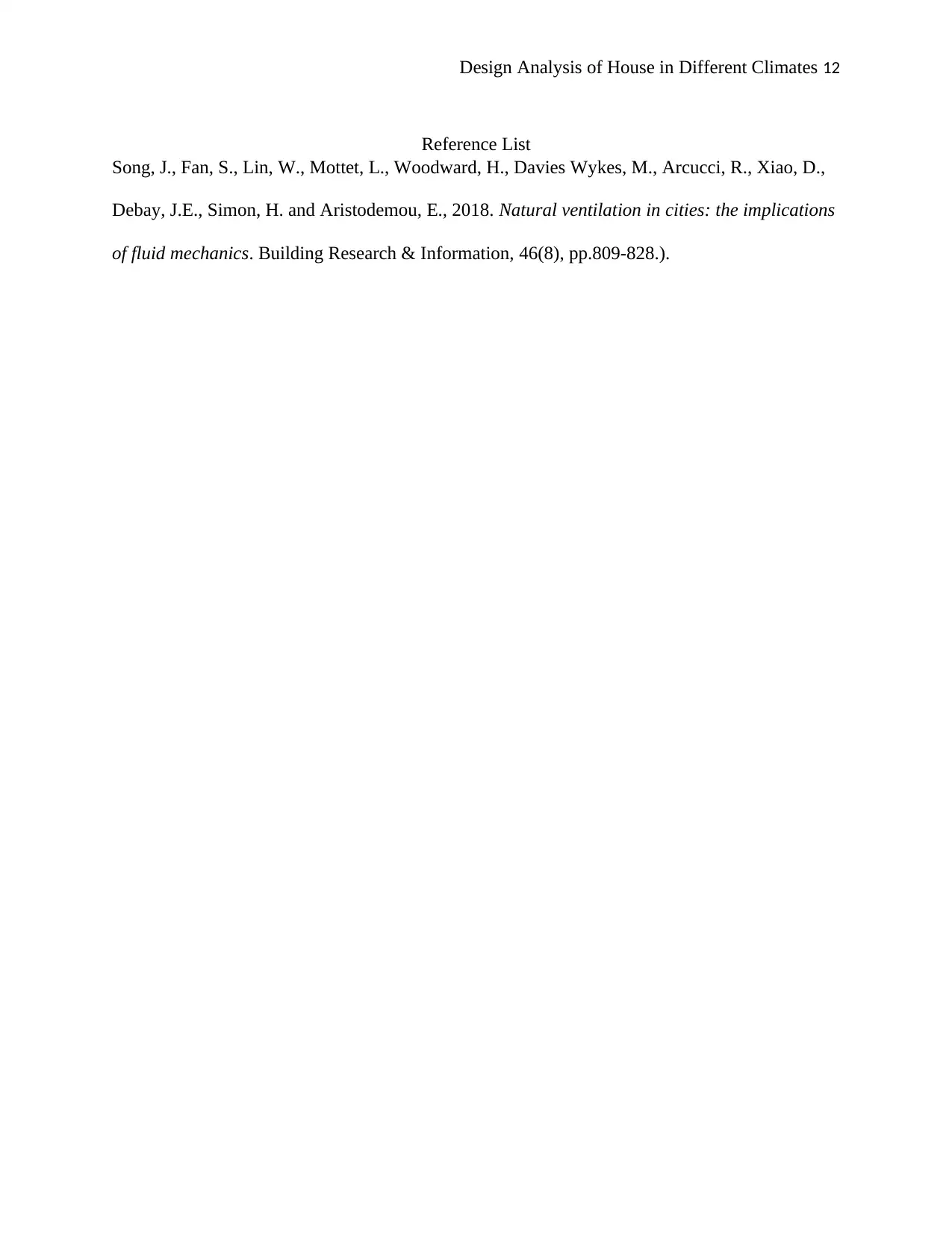
Design Analysis of House in Different Climates 12
Reference List
Song, J., Fan, S., Lin, W., Mottet, L., Woodward, H., Davies Wykes, M., Arcucci, R., Xiao, D.,
Debay, J.E., Simon, H. and Aristodemou, E., 2018. Natural ventilation in cities: the implications
of fluid mechanics. Building Research & Information, 46(8), pp.809-828.).
Reference List
Song, J., Fan, S., Lin, W., Mottet, L., Woodward, H., Davies Wykes, M., Arcucci, R., Xiao, D.,
Debay, J.E., Simon, H. and Aristodemou, E., 2018. Natural ventilation in cities: the implications
of fluid mechanics. Building Research & Information, 46(8), pp.809-828.).
⊘ This is a preview!⊘
Do you want full access?
Subscribe today to unlock all pages.

Trusted by 1+ million students worldwide
1 out of 12
Related Documents
Your All-in-One AI-Powered Toolkit for Academic Success.
+13062052269
info@desklib.com
Available 24*7 on WhatsApp / Email
![[object Object]](/_next/static/media/star-bottom.7253800d.svg)
Unlock your academic potential
Copyright © 2020–2025 A2Z Services. All Rights Reserved. Developed and managed by ZUCOL.




